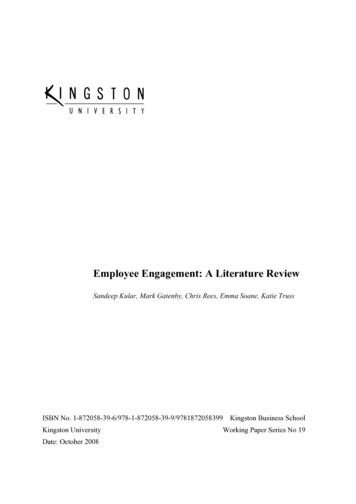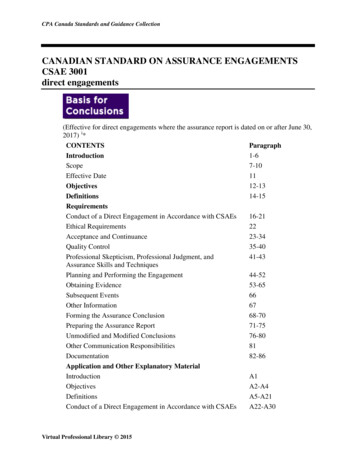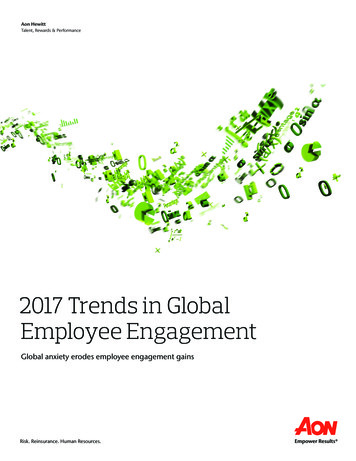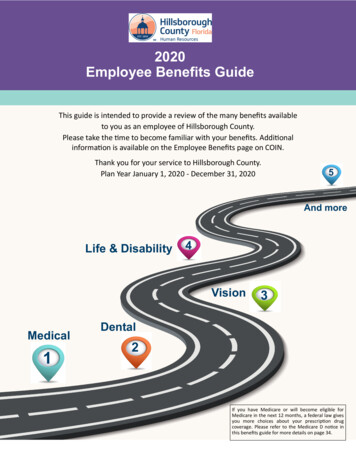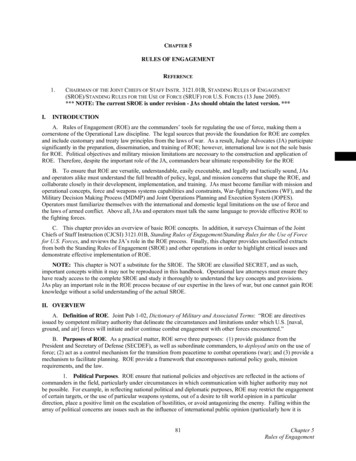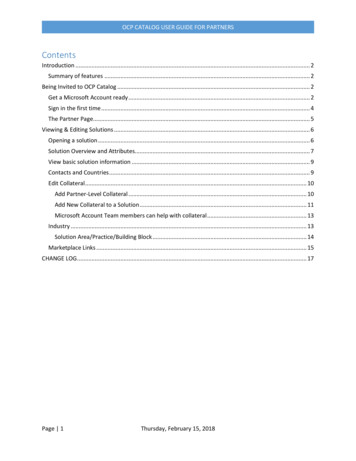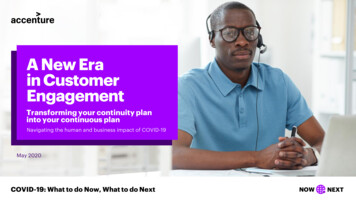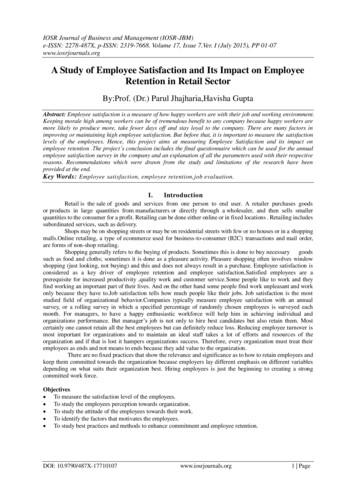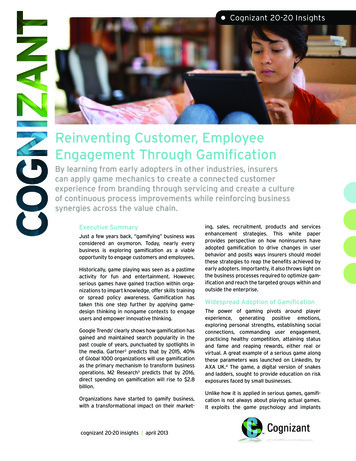
Transcription
Cognizant 20-20 InsightsReinventing Customer, EmployeeEngagement Through GamificationBy learning from early adopters in other industries, insurerscan apply game mechanics to create a connected customerexperience from branding through servicing and create a cultureof continuous process improvements while reinforcing businesssynergies across the value chain.Executive SummaryJust a few years back, “gamifying” business wasconsidered an oxymoron. Today, nearly everybusiness is exploring gamification as a viableopportunity to engage customers and employees.Historically, game playing was seen as a pastimeactivity for fun and entertainment. However,serious games have gained traction within organizations to impart knowledge, offer skills trainingor spread policy awareness. Gamification hastaken this one step further by applying gamedesign thinking in nongame contexts to engageusers and empower innovative thinking.Google Trends1 clearly shows how gamification hasgained and maintained search popularity in thepast couple of years, punctuated by spotlights inthe media. Gartner2 predicts that by 2015, 40%of Global 1000 organizations will use gamificationas the primary mechanism to transform businessoperations. M2 Research3 predicts that by 2016,direct spending on gamification will rise to 2.8billion.Organizations have started to gamify business,with a transformational impact on their market-cognizant 20-20 insights april 2013ing, sales, recruitment, products and servicesenhancement strategies. This white paperprovides perspective on how noninsurers haveadopted gamification to drive changes in userbehavior and posits ways insurers should modelthese strategies to reap the benefits achieved byearly adopters. Importantly, it also throws light onthe business processes required to optimize gamification and reach the targeted groups within andoutside the enterprise.Widespread Adoption of GamificationThe power of gaming pivots around playerexperience, generating positive emotions,exploring personal strengths, establishing socialconnections, commanding user engagement,practicing healthy competition, attaining statusand fame and reaping rewards, either real orvirtual. A great example of a serious game alongthese parameters was launched on LinkedIn, byAXA UK.4 The game, a digital version of snakesand ladders, sought to provide education on riskexposures faced by small businesses.Unlike how it is applied in serious games, gamification is not always about playing actual games.It exploits the game psychology and implants
Gamification Efforts and BenefitsBusinessObjectiveGamification InitiativeIncreaseSpeed toMarketThreadless,5 a Chicago-based T-shirtcompany, crowdsourced T-shirt designsthrough weekly contests. Customers vote onthe designs and winning designs are manufactured each week.Threadless tapped into 100,000graphic designers and achieved 3million to 4 million monthly visitors.User-centricNike has become a unique productcategory and pushed competition toemulate its success. Nike ’s onlinecommunity has more than 2 millionactive members. All members haverun over 120-million miles, achieved240,000 daily goals and earned over220,000 e 6 sensor in the shoe tracks data aboutthe workout activities such as running speed,distance covered, calories burned, etc. andsyncs with iPod/iPhone. Fitness data isprocessed and reported at NikePlus.com.Users can connect with friends and enterchallenges, too.Buffalo Wild Wings7 restaurant and sports barfranchise launched a 12-week campaign forvisiting guests to participate in competitionsby downloading a location-based gaming app— namely, SCVNGR8 for smartphones.Deep consumer engagement wasachieved with 184,000 unique playersparticipating at 730 locations. In thefirst month, 334,000 challenges werecompleted, generating 100 millionsocial impressions on Facebook andTwitter.User-centricIActionable9 has integrated its Engage gamification app with Salesforce.com to applygame mechanics to traditional sales. Thegamified app allows managers to define goalsand milestones and inserts visual progressdisplays on Salesforce.com pages.Customer service objectives suchas driving more calls, loweringlead response times and improvingconversion rates were met. Achievedat least an 88% increase in overallSalesforce.com eInnovationU.K. Department for Work and Pensions(DWP) created Idea Street10 to generateideas from the 120,000 people across theorganization.The DWP credits Idea Street with morethan 1,000 implemented ideas, andestimates it generated benefits valuedat approximately 20 million.Process-centricAbout 70% to 75% of NextJump’semployees work out regularly. Thissaves the company millions of dollarsin work attendance and insurancecosts, and makes the workplacehealthier and p,11 an offers and rewards companyin New York, built its own internal healthapplication that split the company into fiveteams and rewarded the winning teams forregularly exercising by depositing cash ineach team member’s health savings account.4,500 participants reviewed 500,000dialog boxes; 170 bugs were addressed.Microsoft Japan took just a single dayto weed out all localization soft12 used gamification on top of itsbug testing engine to encourage non-QAstaff to do bug testing.13 The company alsoused gaming for language translations insoftware localization efforts and to publicizetop contributors.Helped in quick diagnosis of underperforming agents. Focused trainingto those agents, and thus improvedcustomer satisfaction ased Arcaris14 has revamped itscall center interface, “Playcall,” — recentlybranded as “PlayVox” — to include gamingmechanics where agents can view theirrelative rankings, customer satisfactionindex, supervisor feedback and other KPIs.They are rewarded based on achieving performance KPIs.OneCognizant15 is Cognizant’s internalemployee engagement platform that usesgame mechanics to engage, reward andmotivate its employees through leaderboardsand badges. It facilitates business processorchestration through an internal app storeand improves employee productivity.The 10 million user hits, 100,000likes, 300-plus apps in app store,enablement of 102 business processesand five engagement channels in playhave contributed to a modest increasein employee satisfaction score, withthree key business processes doublingin user tImproveEmployeeEngagementBusiness ImpactFigure 1cognizant 20-20 insights2GamificationApproach
the intrinsic and extrinsic motivational factorsin a routine task that is performed by a user ina nongame context. Therefore, gamificationinvolves proper application of game mechanics,dynamics and aesthetics with significant consideration of user experience and behavioralmotivators. Leveraging these techniques, somebusinesses have experimented with gamification and have achieved tremendous success inengaging their customers.Recently, gamification experiments have surfacedin several domains. Figure 1 (on the precedingpage) depicts a number of the significant gamification initiatives undertaken across variousindustry sectors, highlighting their approacheswith associated business objectives.Gamification for InsurersAs for any industry, embracing a gamificationstrategy is essential for insurers that wish toensure a connected customer experience frombranding through servicing. In fact, similartactics need to be in place to engage underwriters, claims adjusters, fieldGamification representatives and callrepresentatives toplatforms can centercreate a culture of continugenerate voluminous ous process improvementsand valuable data and to reinforce businessacross the valuefor predictive and synergieschain. Insurers should alsopervasive analytics, extend gamification techallowing insurers niques to motivate their salesfrom captive agentsto gain better forces,and independent agentsunderstanding of through brokers, to optimizecustomer behaviors outcomes across the producmarketing and disand risk profiles. er-basedtribution system.Figure 2 (on the following page) highlights theinsurance industry’s external- and internal-facingareas where gamification applies. While externalfacing refers to engagement with customers andprospects, internal facing refers to engagementwith the internal employees — agents, brokers,call center representatives and other partners/vendors.touch points. All of these touch points shouldseamlessly integrate into a unified brand rewardprogram. For instance, the rewards program shouldencourage the customer to participate in a socialcommunity ideation, provide an online reviewor feedback on a product and/or finish a policypurchase in a mobile channel to accumulate pointstoward completing a featured quest or challenge.Beyond loyalty and reward programs, a gamification platform can drive insurance customersto undertake sound measures to minimize risks.Recently, Evogi, a usage-based insurance serviceprovider, announced the launch of its new gamedriven, user-based insurance (UBI) platform16for auto insurance companies where customersreceive immediate feedback on their drivingbehavior in a virtual 3-D live map. Such initiativesreinforce the benefits of better driving habits andsimultaneously let customers take full advantageof behavior-based pricing. Gamification platformscan generate voluminous and valuable datafor predictive and pervasive analytics, allowinginsurers to gain better understanding of customerbehaviors and risk profiles.Increase Brand Awareness andSales Conversion Branding: Like other consumer-orientedcompanies, insurance carriers should exploregamification to foster better participation bytheir customers. With gamification initiatives inplace, customers can connect to the brand ata personal level. Insurers must aim to converttheir customers into brand ambassadors topromote the brand image of the carrier’sproducts and services by motivating themappropriately. This could simply range fromincluding game-like features in the carrier’sWeb site to attract frequent visits, encouraging a “Like” in a Facebook fan page or enrollingthe existing policyholders in featured quests orsweepstakes. The ultimate goal is to increasebrand visibility through a behavior-basedengagement approach. Marketing and sales: Given the varied dynamics of marketing and distribution systems andthe nature of the commodity being sold, insurers face huge challenges in engaging directlywith customers in ways that foster enduringrelationships. Figure 3 (also on the followingpage) illustrates the high-level steps for developing tailored customer engagement strategies embedding gamification elements in directversus producer-based marketing and salessystems.External FacingWith the advent of emerging technologies, traditional loyalty and reward programs are becomingless relevant. Rather than creating a one-time flatreward experience as part of a routine transaction,gamification can help insurers support long-lastingengagement by rewarding in layers across multiplecognizant 20-20 insights3
Gamification in an Insurance Industry ationMarketResearchIdeation/InnovationMarketingand entOnboardand itmentFigure 2Insurers can create targeted advertisingcampaigns that let customers play games,accrue points and convert them into tangibleor virtual rewards. This strategy works particularly well with audiences who favor mobileand social gaming. Insurers can also rewardexisting policyholders for referring friends andcolleagues. For example, insurers can replicateGroupon17 models that encourage customers tohunt for big discounts while enrolling a specificnumber of customers into their communities tobuy similar coverage.leader-board. From there, insurers can identifycross-sell and up-sell opportunities by encouraging the users to share additional content,particularly in their social channels. Performingsocial analytics on top of the increased usergenerated content can help insurers to spotreferrals and sales conversions.Improve Customer Engagement,Loyalty and Service For instance, if a family member purchasesindividual life coverage and encouragesat least five members of his household topurchase similar coverage, they could enjoyprivileged customer status or access premiumservices. Rather than rewarding them for thisdeal alone, the insurer should encourage thefamily to accumulate points and cross multiplelevels in their mission to consistently top theCustomer education: Gamification can beused by insurance carriers to educate theircustomers on risk exposure management,safe driving measures and safe maintenanceof vehicles, personal financial planning,smart investments, retirement planning andselection of the right coverage. This could bea serious game or a quiz hosted online, mobileor on a social channel. Upon completing thegame, customers should be awarded badges.Completion of certain assignments can be tiedCodifying GamificationDirect Marketingand SalesProducer-BasedMarketing and SalesDevise customerengagement strategy.Devise strategy to influenceagent behavior andmotivate sales force.Create engaging contenton online, mobile andsocial channels.Enable agents withcontent and tools toengage customers.Incentivizecustomers.Incentivize agentsand customers.Figure 3cognizant 20-20 insights4
back to transactions by providing discounts.For instance, traditional rebates such as “goodstudent discounts” can be applied to gamification to improve customer engagement(i.e., where students can be encouraged tosubmit evidence of improved grades or otheracademic accomplishments and be rewardedwith premium decreases). Top ranking studentscan be publicized. On a similar basis, consistentsafe driving and setting of driving improvement goals can be incentivized. Customer feedback: Insurers must developinnovative means of collecting feedbackfrom customers through gamification. Anymeaningful feedback that customers shareabout carrier products or services can qualifyfor incentives. A gamification approach mighthelp to encourage customers to providefeedback compared with traditional feedbackforums. Customer retention: Retention of customersis among the critical goals for an insurer; gamification can be of service by creating a senseof belongingness. Nexercise18 aims to cementuser activity levels like burning calories andreward them with points that can be redeemedon “healthy choice” deals. Insurers can createsimilar initiatives that focus on reducinghazards that will help with retention. Market research: Traditional market researchsurveys launched with an aim to provideenhanced customer-centric service involvingconsumer participation can be replacedwith game-like survey questionnaires. (Forexample, Nexercise’s game-based surveythat offers rewards to motivate consumersto lose weight.) Customers can be incentivized based on valuable feedback. Crowdtap19reduced research costs by 80% for key clientsby offering consumers gamified rewardsto complete research tasks and therebyconverting customers into brand advocates.The company raised 1 million in revenue andenrolled 100,000 users in just 90 days.jacking and other forms of identification theft.Such innovative ideas can be pooled fromthe customer community through gamification strategies to launch niche products in themarket. For instance, Fiat launched its FiatMio21 project Web site by inviting people to helpcreate a car for the future — in effect, designingthe world’s first crowdsourced car.Internal FacingOften, insurance company employees aresubjected to tasks that are tedious and laborintensive. For example a juniorunderwriter in commercial Gamification is oftenlines might need to collect considered a means ofhuge sets of data, resulting ininducing competition.user fatigue. Or an agent couldbe de-motivated in his pursuit The head fake is thatof stiff annual sales targets.gamification canByapplyinggamification become an effectivetechniques such as progress tool to enhancebars and badges, such employcollaboration andees could better understand their performance and maximize businesscompete against themselves value.and their peers to achievepersonal and business goals. They can be providedwith timely tips and the means to achieve thosetargets based on their current performance.Importantly, gamification, if applied correctly,can induce behavioral changes that enhanceemployee productivity. Overall, employees, thesales force in particular, gain a sense of pride,belongingness and accomplishment whenrecognized for smaller tasks that contribute to alarger business objective.Improve Employee/Partner Engagementand Productivity Gain Competitive Advantage Ideation/innovation: Insurers should look tocrowdsource ideas from customers on productdevelopment and reward top contributors.They can invite the customers to come upwith new product ideas based on changinglifestyle patterns. Recently, a UK-basedcompany, ALLOW,20 introduced a “social mediainsurance” product with the intent of protectingcustomers from reputational damage, accountcognizant 20-20 insights5Employee collaboration: Gamification isoften considered a means of inducing competition. The head fake is that gamificationcan become an effective tool to enhance collaboration and maximize business value. Forinstance, consultant Bluewolf22 has gamifiedenterprise knowledge sharing and incentivizedits employees to go social. In the insurancecontext, an SME from the claims departmentcould assist a junior claims adjuster on thesettlement dispute of a multi-vehicle collisioncase and earn the status of a top contributorin the carrier’s collaboration platform. A groupof agents, field sales and corporate sales representatives might be willing to collaborate with
each other if they are continuously remindedthat the agency is well positioned to bag tophonors for achieving the best sales conversionrate. Apart from personalized targets, settingup team goals by grouping teams based ondepartment or region and indicating theirprogress and visibility to the end result on aperiodic basis through a gamification platformcan yield richer dividends. Performance management: Gamification canbe effectively applied to the context of performance management if goals and key performance indicators are captured upfront andfed into the design of the platform. A leaderboard dashboard can be seamlessly linked withactivities that contribute to performance goals,while others might help employees qualify formere badges but not contribute to the actualKPIs. Figure 4 illustrates a sample leaderboardfor agents.Processimprovement: Gamified toolsdeployed to track tasks and daily assignmentsengage employees better than the traditionaltask tracking systems. Gamifying mundanework performed by call center representative or junior underwriters should be a keyfocal point. For instance, a call center representatives who attends to the first notice ofloss calls from customers can be motivatedif he is allowed to track his SLA through agamified platform. Reps could track their performance relative to the other team membersand also receive badges for completing taskson schedule, receiving customer testimonials,accurately capturing all relevant information,avoiding round-trip time for the claims adjusteror helping a fellow employee by answeringqueries. This should drive productivity gainsand encourage collaboration to share bestpractices across the call center team.Typically, leaderboards contain a visualdashboard that reflects the activitiespertaining to the logged-in user. The progressbars are used to provide real-time feedback andinfluence user behavior by indicating employeeprogress against goals.For example, a claims estimator would be ableto ascertain which scheduled tasks can earnhim points by being completed on time, whatexpert queries he can answer to accumulatemore points and his ranking relative to histeam, region and global standings. Similarly,an agent can view his relative rankings,check progress in terms of accomplishing thequarterly or annual sales target, see featuredsales challenges that can earn him more points,check on recent badges that he has won, etc.Gaming PerformanceFeaturedchallengesMy LeaderboardJohn MattQ2 2013 –Opportunity to win500 points andearn sales king ofthe quarter badge44,000 pointsTeam Ranking: 8Global Ranking: 102Click to viewDashboardYour ProgressYour recent badgesYour Annual sales target 25,000YourProgress72%LikeLikeJim earned 50points for newbusinessopportunityComment750Click here toRedeem pointsYour Team dolph44,500MoreJohn Matt44,000MoreGeorgeBeck42,500MoreFigure 4cognizant 20-20 insights1500View MoreChallenges15%6Recent ActivitiesTommy tops theglobal standingsfor Q1 2013CommentRecently completedchallenges6
Winning Leaderboard AttributesQualify for Qualify omer testimonyKudosbadge150NoYesSupervisor/peer appreciationKudosbadge125NoYesCompletion of internal trainingand certification programAcademybadge1 perprogram100YesYesCompletion of external trainingand certification programAcademybadge1 perprogram150YesYesQuarterly challengesChallengerbadge1 perchallenge150YesYesCompleting 5 years of servicewith agencyLongservicebadge1 per 5 years1000NoYesAnswering expert queries incommunity forumSME badge1 post50YesYesNumber of leads generatedMain KPI150YesNoNew business sales deal closedMain KPI1200YesNoRenewals sales deal closedMain KPI175YesNoUp-sellMain KPI1100YesNoCross-sellMain KPI1150YesNoCustom product ideasMain KPI1200YesYesAchieving annual sales targetMain KPI1500YesYesRetaining 90% clientele frompast yearAdditionalKPI1 per year250YesYesFigure 5Figure 5 highlights the sample list of activities,points and badges that an insurance agentleaderboard can award and track.For instance, SAP23 displays the number ofclosed deals of every region as app race scoresrather than pie charts. They have an interesting visualization of sales analytics. Nitro24 forSalesforce helps foster healthy competitionwithin its sales teams by providing motivational challenges, contests and quests. Suchleaderboards can be designed by insurers toinstitute a performance management systemthat increases employee efficiency.list to prove their credibility. For a carrier thatis looking to attract fresh talent, gamificationcan be included to encourage referrals fromthe existing employee pool. Similar to crowdsourced ideas, crowdsourced recruitment is aninnovative approach where existing employeesare effectively engaged to attract high-performing talent from the market. Reduce Operational Costs Recruitment: Gamification was recentlyleveraged by certain companies for recruitingskilled professionals. The knowledge of agents,for instance, can be virtually tested throughinterview questionnaires that include gamemechanics. They can also be encouraged tobring references from their existing clientelecognizant 20-20 insights7Onboarding, training and decision-making:While serious games are already quite popularfor onboarding and training, publicizing thetop and consistent performers through leaderboards can motivate employees to consistentlyupgrade their skills. One way insurers canleverage such platforms is to onboard/traintheir employees, agents, brokers, sales representatives and call center representatives.Another application is to provide a gamification platform for underwriters, claim representatives and risk engineers to simulate decisionmaking scenarios.
Increase Speed to Market Product development: Insurers should lookto gamify their current product developmentinitiatives to better engage their employees.Resulting product development ideas can beevaluated based on their feasibility, uniquenessand business value, and the contributors canbe recognized. Those who contribute consistently can be rewarded annually so employeeengagement is persistent and seamless. Theresult: agents, brokers and the associated salesforce are persuaded to remain close to thecustomer. As such, insurers should encourageall associates to participate in product development initiatives to build self-esteem andincrease speed to market.Ideation/innovation: Analogous to thecustomer context, insurers should crowdsourceideas from internal employees to drive andsustain innovation. This will help in effectiveproblem solving and exploring fresh territories, and it will serve as a creative outlet foremployees to stay motivated. A few breakthrough ideas from the workforce on theground could be a market differentiator.Looking AheadGamification provides ample opportunities forP&C and life insurers to strengthen customerrelationships, engage their employee workforceand motivate their sales people. Apart from this,insurers can generate useful content and conversations among internal and external audiencesactive on the gamified platforms.By applying advanced analytics on top of theseconversations, insurers can garner business intelligence insights that can generate new productideas or reveal sales promotion opportunities.Gamification drives users towards systems ofengagement and persuades them, either consciously or subconsciously, to achieve targetedgoals with improved effectiveness and efficiency.These techniques seed long-term relationships,increase customer loyalty, reward individualactions that roll up to achieve a larger businessobjective and provide instant feedbacks.While gamification has clearly proven to be aneffective engagement tactic, insurers should bemindful, prior to implementation, to deploy gamification as a means to solve business problemsrather than merely identifying areas to applygamification. Interactive design, knowing thetarget audience and clear definition of the rulesof engagement also play a crucial role in ensuringsuccess. By adopting best practices from otherindustries on the gamification front, insurersshould be able to capitalize on business opportunities before it is too late in the ore#q o100-june1-2012?year 2012.cognizant 20-20 insights8
t the AuthorsAkila Narayanan is a Manager with the Insurance Future of Work Group within Cognizant’s InsuranceBusiness Unit. She is a social business enthusiast and evangelist with vast experience managing complexand strategic projects for insurers. Akila is an avid blogger and specializes in enabling social businessfor insurers. She holds a bachelor’s degree in engineering from University of Madras and is PMP, AINScertified. She can be reached at Akila.Narayanan@cognizant.com.Deepak Maruvapalli is a Senior Architect with the Insurance Future of Work Group within Cognizant’sInsurance Business Unit. He focuses on mobility strategies for insurers and has a keen interest in gaming.Deepak has architected and executed mobile projects for insurers and he also has vast experience inarchitecting and executing projects with diverse modern technologies. Deepak holds a bachelor’s degreein engineering and is a certified SOA Associate and TOGAF 8 Certified Enterprise Architect. He can bereached at Deepak.Maruvapalli@cognizant.com.Shyam Sundar Nagarajan is a Principal Architect with the Insurance Future of Work Group within Cognizant’s Insurance Business Unit. He has vast experience architecting and executing enterprise legacymodernization projects for insurance carriers. Shyam’s areas of interest include application architecture, legacy modernization, Agile methodologies, SOA, GIS, location-based services, location intelligence, mobility and social. His current focus areas include envisioning future of work for insurers withredefined application architecture. Shyam holds a B.Tech. degree from the Indian Institute of Technology– Banaras Hindu University and a master’s degree in software systems from Birla Institute of Technologyand Science, Pilani. He is an IBM certified Service Oriented Architecture Associate and TOGAF 8 CertifiedEnterprise Architect. He can be reached at ShyamSundar.Nagarajan@cognizant.com.About CognizantCognizant (NASDAQ: CTSH) is a leading provider of information technology, consulting, and business process outsourcing services, dedicated to helping the world’s leading companies build stronger businesses. Headquartered inTeaneck, New Jersey (U.S.), Cognizant combines a passion for client satisfaction, technology innovation, deep industryand business process expertise, and a global, collab
Gamification Efforts and Benefits. Business Objective Gamification Initiative Business Impact Gamification Approach. Increase Speed to Market Threadless, 5. a Chicago-based T-shirt company, crowdsourced T-shirt designs through weekly contests. Customers vote on the designs and winning design

